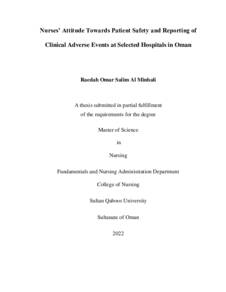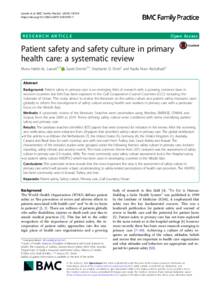Document
Nurses' attitude towards patient safety and reporting of clinical adverse events at selected hospitals in Oman.
Other titles
الممرضات تجاه سلامة المرضى والإبلاغ عن الأحداث السريرية الضائرة في مستشفيات مختارة في سلطنة عمان
Publisher
Sultan Qaboos University.
Gregorian
2022
Language
English
English abstract
Background: Clinical Adverse Events are major causes of mortality in hospitals and
significantly influence patient safety, causing an economic burden on the healthcare system.
Most hospital adverse events are linked to attitudes of healthcare professionals towards
safety.
Purpose: The aim of this study was to assess the relationship between nurses' attitudes
toward patient safety and their reporting of clinical adverse events and adverse patient events.
Methods: A descriptive, cross-sectional design was used to conduct the study in Sultan
Qaboos Hospital, Salalah and Royal Hospital, Muscat, with participants recruited from the
inpatient units. Data to evaluate nurses' attitudes towards patient safety was collected using
the Safety Attitude Questionnaires (SAQ), while the data for attitude towards reporting
clinical adverse events were collected using Reporting of Clinical Adverse Events Scale
(RoCAES). The data on the type of adverse events (AEs) was collected using the Adverse
Patient Events Scale (APES).
Results: Hundred and eighty-four questionnaires were administered from February to April
2022, with a response rate of 96.8%. The results showed nurses had an overall low positive
perception of patient safety and reporting of adverse clinical events. Recognition of stress
(M=3.102, SD=0.944) and clarity of reporting adverse events (M= 4.40, SD=1.640) attracted
the lowest safety score. Patient and family complaints (M=1.96, SD=1.846) had the highest
AEs reporting over the past year. There was no significant association between nurses'
patient safety perception and their attitude towards RoCAE. Linear regression analysis
showed nurses' attitude towards patient safety (β= -0.176±0.146; p = 0.026), and their
attitude toward RoCAE (β= 0.185±0.01; p = 0.016) and nurses-patient staffing ratio (β=0.228
±0.024; p=0.016) were predictors of AEs in clinical areas.
Conclusion: There was a low positive safety culture among nurses, and nurses' attitude
towards reporting clinical adverse events was generally negative. Patient and family
complaints were the commonest adverse events, followed by patient and family verbal abuse,
nosocomial infection, medication errors, and patient fall, respectively. The study also found
that complaints were occurring more frequently than in previous studies conducted in Oman.
Furthermore, there was no significant relationship between nurses' attitudes toward patient
safety and their attitude towards reporting clinical adverse events. Finally, the nurses'
attitudes towards patient safety and their attitudes toward reporting clinical adverse events
and nurse-patient staffing ratio were predictors contributing to the occurrence of adverse
patient events. These findings provide key insights about patient safety status in Oman that
key stakeholders in the hospitals and the ministry of health could use to improve safety
culture, including raising patient safety awareness.
Member of
Resource URL
Arabic abstract
المقدمة :تعتبر الاحداث الضائرة السريرية من الاسباب الرئيسية للوفيات في المستشفيات. وتؤثر هذه الاحداث الضائرة بشكل كبير على سلامة المرضى، كما أنها تسبب عبء اقتصادي في نظام الرعاية الصحية. ترتبط معظم الاحداث الضائرة في المستشفى بمواقف المتخصصين في الرعاية الصحية تجاه السلامة. الهدف: كان الهدف من هذه الدراسة هو تقييم العلاقة بين موقف الممرضات تجاه سلامة المرضى، والابلاغ عن الاحداث الضائرة السريرية، والاحداث الضائرة للمريض. الطريقة: تم استخدام تصميم البحث الوصفي، المقطعي؛ لإجراء الدراسة في مستشفى السلطان قابوس بصلالة، والمستشفى السلطاني بمسقط. تم تجنيد المشاركين من وحدات المرضى بالاقسام الداخلية بجميع انحاء المستشفيات ذات الرعاية الصحية من المستوى الثالث. وتم جمع البيانات المستخدمة لتقييم موقف الممرضات تجاه سلامة المرضى باستخدام استبيانات موافق السلامة )SAQ)، بينما تم البيانات الخاصة بالموفق تجاه الابلاغ عن الاحداث الضائرة السريرية باستخدام مقياس الابلاغ عن الاحداث الضائرة السريرية )RoCAES). وأخيرا تم جمع البيانات المتعلقة بنوع الاحداث الضائرة للمريض باستخدام مقياس الاحداث الضائرة للمريض )APES). النتائج: تم جمع مائة وأربعة وثمانون استبيان خالل الفترة من فبراير إلى أبريل ،2022 حيث بلغ معدل الاستجابة .%96.8 أشارت النتائج إلى أن لدى الممرضات بشكل عام تصور إيجابي منخفض تجاه سلامة المرضى، والابلاغ عن الاحداث السريرية الضائرة. جذب التعرف على الاجهاد )SD 3.102,=M=0.944 )ووضوح الابلاغ عن الاحداث الضائرة )SD 4.40,= M=1.640 )أدنى درجات السلامة. علاوة على ذلك سجلت شكاوى المرضى والاسرة ) 1.96,=M SD=1.846 )أعلى معدل للإبلاغ خلال العام الماضي. وأظهرت النتائج عدم وجود ارتباط كبير بين إدراك الممرضات لسلامة المرضي، وموقفهم تجاه الابلاغ عن الاحداث السريرية الضائرة. ومع ذلك أظهر تحليل الانحدار الخطي أن مواقف الممرضات تجاه سلامة المريض )p; -0.176±0.146= β = 0.026)، وموقفهم تجاه الابلاغ عن الاحداث السريرية الضائرة )p; 0.185±0.01= β = 0.016)، ونسبة توظيف الممرضات إلى المرضي ) ;±0.024 0.228=β بالاحداث الضائرة في المجالات السريرية. p=0.016 )كانت تنبئاًمهماً الخاتمة: وجدت الدراسة أن ثقافة السلامة الايجابية منخفضة بين الممرضات وموقف الممرضات تجاه الابلاغ عن الاحداث الضائرة السريرية أيضا سلبية بشكل عام. علاوة على ذلك، كانت شكاوى المرضى والاسرة من الاحداث الضائرة هي الاكثر شيوعا تليها الاساءة اللفظية للمريض والاسرة، وعدوى المستشفيات، والاخطاء الدوائية، وسقوط المريض على التوالي. وجدت الدراسة أيضا أن الشكاوى كانت تحدث في كثير من الاحيان أكثر مما ورد في الدراسات السابقة في عمان. علاوة على ذلك، لم نجد علاقة ذات دلالة إحصائية بين موقف الممرضات تجاه سلامة المرضى وموقفهم تجاه الابلاغ عن الاحداث الضائرة السريرية. أخيرا، كانت مواقف الممرضات تجاه سلامة المرضى، ومواقفهم تجاه الابلاغ عن الاحداث الضائرة السريرية ونسبة تعيين الممرضات إلى المرضى، متنبئات تساهم في الاحداث الضائرة للمريض. توفر هذه النتائج رؤى رئيسية حول سلامة المرضى بحيث يمكن لأصحاب المصلحة الرئيسيين في المستشفيات ووزارة الصحة استخدامها لتحسين ثقافة السلامة بما في ذلك زيادة الوعي سلامة المرضى.
Category
Theses and Dissertations


